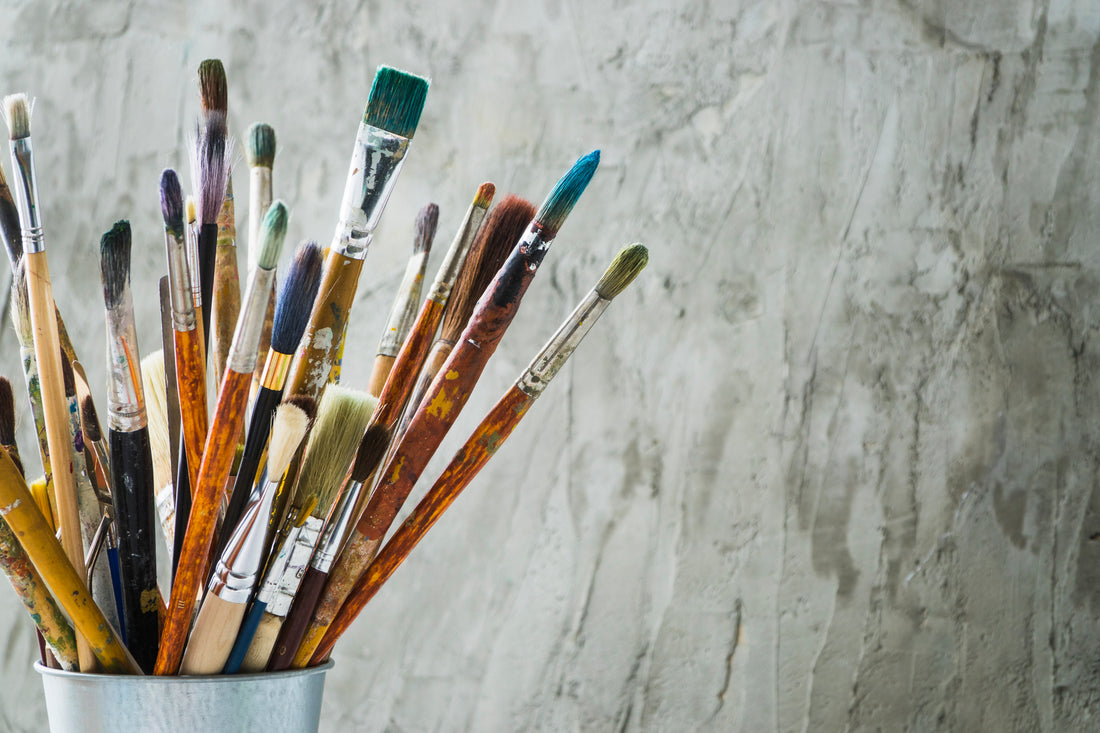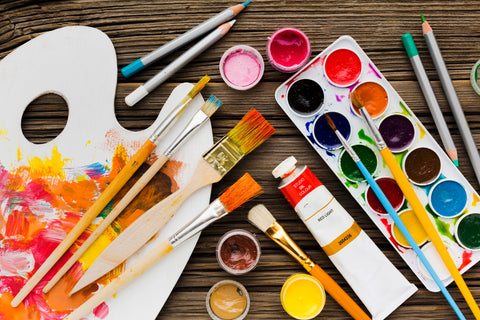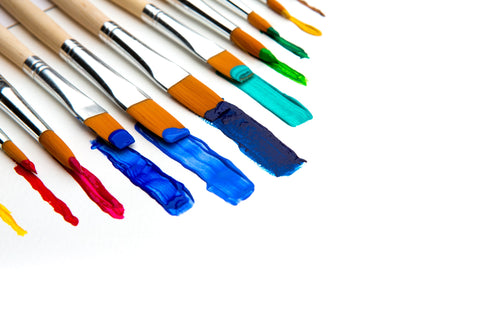
So reinigen und pflegen Sie Ihre Pinsel beim Malen nach Zahlen
Aktie
Haben Sie schon einmal ein Malen-nach-Zahlen-Projekt in Angriff genommen und festgestellt, dass Ihre Pinsel nach nur wenigen Anwendungen in einem traurigen Zustand waren? Damit Sie schöne, konsistente Ergebnisse bei Ihren Gemälden erzielen, müssen Sie Ihre Pinsel sauber und gut pflegen. In diesem Blogbeitrag befassen wir uns mit der Bedeutung regelmäßiger Reinigung, den Materialien und Techniken, die Sie benötigen, um Ihre Pinsel in Top-Zustand zu halten, und geben zusätzliche Tipps, um ihre Langlebigkeit zu erhalten. Verabschieden Sie sich von ausgetrockneten, ausgefransten Pinseln und begrüßen Sie ein Malerlebnis, das so glatt ist wie Ihre Pinselstriche. Tauchen Sie ein!
Die Grundlagen verstehen: So halten Sie Ihre Pinsel sauber und gut gepflegt
Die Pinsel sauber und gut gepflegt zu halten, ist für jeden Künstler wichtig, insbesondere bei einem Malen-nach-Zahlen-Projekt. Die richtige Pinselpflege verlängert nicht nur ihre Lebensdauer, sondern sorgt auch dafür, dass Ihre Bilder frei von unerwünschten Streifen, Klumpen oder Farbverunreinigungen sind. In diesem Abschnitt werden wir die Grundlagen der Pinselpflege untersuchen, einschließlich der Gründe, warum regelmäßiges Reinigen so wichtig ist, und der Materialien, die Sie benötigen, um Ihre Pinsel in makellosem Zustand zu halten.
Warum regelmäßige Reinigung wichtig ist
Die regelmäßige Reinigung Ihrer Pinsel ist aus mehreren Gründen wichtig:
-
Farbentfernung : Durch gründliches Reinigen Ihrer Pinsel werden alle Farbreste entfernt, wodurch Farbvermischungen und Verunreinigungen vermieden werden. Dies ist besonders wichtig, wenn Sie an einem Malen-nach-Zahlen-Projekt arbeiten, bei dem präzise Farben unerlässlich sind.
-
Die Pinselform beibehalten : Wenn Farbe auf den Borsten trocknet, können diese steif werden und ihre Form verlieren. Regelmäßiges Reinigen hilft dabei, die ursprüngliche Form des Pinsels beizubehalten, was präzisere und kontrolliertere Pinselstriche ermöglicht.
-
Ablagerungen verhindern : Mit der Zeit kann sich Farbe in der Zwinge (dem Metallteil, das die Borsten hält) ansammeln und dazu führen, dass sich die Borsten spreizen oder verformen. Durch Reinigen werden diese Ablagerungen verhindert und sichergestellt, dass Ihre Pinsel in optimalem Zustand bleiben.
Zur Reinigung benötigte Materialien
Bevor Sie mit dem Reinigungsvorgang beginnen, legen Sie sich folgende Materialien zurecht:
-
Wasser : Sauberes, lauwarmes Wasser ist das wichtigste Lösungsmittel zum Entfernen wasserbasierter Farben von Ihren Pinseln. Es sollte eine Temperatur haben, die für Ihre Hände angenehm ist.
-
Pinselreiniger : Je nach verwendeter Farbart (Acryl-, Öl- oder Aquarellfarbe) benötigen Sie möglicherweise einen speziellen Pinselreiniger. Diese Reiniger sind so formuliert, dass sie Farbe effektiv auflösen und entfernen.
-
Milde Seife : Für eine gründliche Reinigung können Sie ein mildes Spülmittel oder eine Bürstenseife in Kombination mit Wasser verwenden. Vermeiden Sie die Verwendung scharfer Reinigungsmittel oder Lösungsmittel, die die Borsten beschädigen können.
-
Palette oder Teller : Sie benötigen eine Palette oder einen Teller, um Ihren Pinselreiniger oder Ihre Seife mit Wasser zu mischen und damit Ihre Pinsel zu reinigen.
-
Fusselfreie Tücher oder Papiertücher : Diese sind wichtig zum Trocknen Ihrer Pinsel nach der Reinigung und zum Abwischen überschüssiger Feuchtigkeit.
Nachdem Sie nun die erforderlichen Materialien beisammen haben, können wir im nächsten Abschnitt mit der schrittweisen Reinigungsprozedur fortfahren.

So reinigen Sie Ihre Pinsel während eines Malen-nach-Zahlen-Projekts
Das Reinigen Ihrer Pinsel während eines Malen-nach-Zahlen-Projekts ist entscheidend, um ihre Leistung aufrechtzuerhalten und die Integrität Ihres Gemäldes zu gewährleisten. In diesem Abschnitt besprechen wir das schrittweise Reinigungsverfahren, einschließlich der Wichtigkeit regelmäßiger Reinigung, der Techniken zum effektiven Entfernen von Farbe und der richtigen Pflege, um Schäden an Ihren Pinseln zu vermeiden.
Warum regelmäßige Reinigung wichtig ist
Das regelmäßige Reinigen Ihrer Pinsel während eines Malen-nach-Zahlen-Projekts bietet mehrere Vorteile:
-
Farbgenauigkeit : Durch das Reinigen Ihrer Pinsel zwischen Farbwechseln erzielen Sie präzise und lebendige Farben. Dadurch wird Farbvermischung und -verunreinigung verhindert, sodass jeder Abschnitt Ihres Gemäldes präzise mit der beabsichtigten Farbe ausgefüllt werden kann.
-
Reibungsloser Auftrag : Saubere Pinsel sorgen für einen gleichmäßigen und gleichmäßigen Farbauftrag. Ohne Ansammlungen getrockneter Farbe gleiten Ihre Pinselstriche mühelos über die Leinwand und sorgen für ein professionelles Finish.
-
Leistungsfähigkeit des Pinsels erhalten : Durch regelmäßiges Reinigen Ihrer Pinsel verhindern Sie, dass die Farbe auf den Borsten trocknet und aushärtet. Dadurch bleiben die Flexibilität und Form des Pinsels erhalten, was Ihnen eine bessere Kontrolle und Präzision beim Malen ermöglicht.
Schritt-für-Schritt-Reinigungsverfahren
Befolgen Sie diese Schritte, um Ihre Pinsel während Ihres Malen-nach-Zahlen-Projekts effektiv und effizient zu reinigen:
-
Bereiten Sie Ihre Reinigungsstation vor : Richten Sie einen Platz mit einem Wasserbehälter, Bürstenreiniger oder milder Seife und einem fusselfreien Tuch oder Papiertüchern ein. Stellen Sie sicher, dass Sie genügend Platz haben, um bequem arbeiten zu können.
-
Entfernen Sie überschüssige Farbe : Entfernen Sie vor dem Reinigen so viel überschüssige Farbe wie möglich von Ihrem Pinsel, indem Sie ihn vorsichtig am Rand Ihrer Farbpalette oder an einem Papiertuch abwischen. Achten Sie darauf, nicht zu fest zu drücken und die Borsten zu beschädigen.
-
Den Pinsel ausspülen : Tauchen Sie den Pinsel in einen Behälter mit sauberem, lauwarmem Wasser. Schwenken Sie den Pinsel vorsichtig und drücken Sie die Borsten leicht zusammen, um Farbreste zu lösen. Wiederholen Sie diesen Vorgang, bis das Wasser klar ist.
-
Mit Pinselreiniger oder milder Seife reinigen : Je nach verwendeter Farbsorte eine kleine Menge Pinselreiniger oder milde Seife auf die Handfläche oder eine saubere Oberfläche auftragen. Den Pinsel im Reiniger schwenken und in die Borsten einarbeiten. Die Borsten sanft mit den Fingern massieren, um eventuell eingeschlossene Farbe zu entfernen.
-
Ausspülen und wiederholen : Spülen Sie den Pinsel unter klarem Wasser aus, um den Pinselreiniger oder die Seife zu entfernen. Wiederholen Sie den Vorgang bei Bedarf, bis das Wasser klar ist und alle Farbspuren entfernt sind. Stellen Sie sicher, dass keine Seifenreste auf den Borsten verbleiben.
-
Formen Sie die Borsten : Formen Sie die Borsten nach der Reinigung neu, indem Sie sie leicht mit den Fingern zusammendrücken und je nach Art der verwendeten Bürste eine Spitze oder eine flache Kante formen.
-
Trocknen Sie die Bürste : Verwenden Sie ein fusselfreies Tuch oder Papiertücher, um die Borsten sanft abzutupfen und überschüssige Feuchtigkeit zu entfernen. Legen Sie die Bürste flach oder hängen Sie sie kopfüber auf, damit sie vollständig trocknet, bevor Sie sie verstauen oder wieder verwenden.
Wenn Sie diese Schritte befolgen, können Sie Ihre Pinsel sauber und bereit für Ihre nächste Malen-nach-Zahlen-Sitzung halten. Im nächsten Abschnitt erfahren Sie, wie Sie Ihre Pinsel beim Malen pflegen, um ihre Langlebigkeit und Leistung sicherzustellen.

So pflegen Sie Ihre Pinsel beim Malen
Die Pflege Ihrer Pinsel während des Malens ist wichtig, um ihre Langlebigkeit und optimale Leistung sicherzustellen. In diesem Abschnitt besprechen wir die Anzeichen dafür, dass Ihre Pinsel Pflege benötigen, wie Sie die richtigen Reinigungslösungen auswählen und Techniken für die richtige Pinselpflege während Ihres Malen-nach-Zahlen-Projekts.
Anzeichen dafür, dass Ihre Bürsten gewartet werden müssen
Um Ihre Bürsten in gutem Zustand zu halten, ist es wichtig, auf die folgenden Anzeichen zu achten, die darauf hinweisen, dass sie gewartet werden müssen:
-
Steife Borsten : Wenn sich die Borsten Ihres Pinsels steif oder starr anfühlen, kann dies ein Zeichen für angetrocknete Farbansammlungen sein. Dies kann die Flexibilität des Pinsels beeinträchtigen und es schwierig machen, glatte Pinselstriche zu erzielen.
-
Gespreizte Borsten : Wenn sich die Borsten Ihres Pinsels zu spreizen beginnen oder ihre Form verlieren, kann dies die Präzision und Kontrolle Ihres Gemäldes beeinträchtigen. Dies kann eine Folge unsachgemäßer Lagerung oder grober Handhabung sein.
-
Ausgefranste oder gespaltene Borsten : Ausgefranste oder gespaltene Borsten können zu einem ungleichmäßigen Farbauftrag führen und Ihrem Gemälde eine unerwünschte Struktur verleihen. Dies kann durch übermäßigen Druck oder die Verwendung des Pinsels auf rauen Oberflächen passieren.
Wenn Sie eines dieser Anzeichen bemerken, ist es wichtig, umgehend darauf zu reagieren, um die Qualität Ihrer Pinsel zu erhalten.
Auswahl der richtigen Reinigungslösungen
Die Auswahl der geeigneten Reinigungslösungen für Ihre Pinsel ist entscheidend, um Farbe effektiv und ohne Beschädigung zu entfernen. Berücksichtigen Sie bei der Auswahl von Reinigungslösungen die folgenden Faktoren:
-
Farbart : Verschiedene Farbarten erfordern spezielle Reinigungslösungen. Für wasserbasierte Farben wie Acryl- oder Aquarellfarben eignen sich milde Seife und Wasser oder ein spezieller Pinselreiniger für wasserbasierte Farben. Für ölbasierte Farben benötigen Sie möglicherweise ein Lösungsmittel wie geruchloses Lösungsbenzin oder Terpentin.
-
Bürstenmaterial : Manche Bürsten bestehen aus Naturborsten (z. B. Schweineborsten), während andere synthetisch sind. Bürsten mit Naturborsten erfordern besondere Pflege, um Schäden zu vermeiden, während synthetische Bürsten im Allgemeinen widerstandsfähiger sind. Stellen Sie sicher, dass Ihre Reinigungslösung mit der Art Ihrer Borsten kompatibel ist.
-
Umweltfreundliche Optionen : Wenn Sie lieber umweltfreundliche Reinigungslösungen verwenden möchten, informieren Sie sich über die auf dem Markt erhältlichen natürlichen Bürstenreiniger oder Bioseifen.
Befolgen Sie bei der Auswahl von Reinigungslösungen stets die Empfehlungen und Anweisungen des Herstellers, um sicherzustellen, dass diese mit Ihren Bürsten kompatibel sind.
Techniken zur richtigen Bürstenpflege
Wenden Sie die folgenden Techniken an, um Ihre Pinsel beim Malen richtig zu pflegen:
-
Häufiges Reinigen : Reinigen Sie Ihre Pinsel während Ihres Malen-nach-Zahlen-Projekts regelmäßig, insbesondere beim Farbwechsel. Dadurch wird verhindert, dass Farbe trocknet und sich auf den Borsten ansammelt.
-
Schonende Handhabung : Vermeiden Sie beim Streichen übermäßigen Druck oder Schrubbbewegungen. Zu viel Kraft kann die Borsten beschädigen und zu vorzeitigem Verschleiß führen.
-
Vermeiden Sie das Eintauchen der Zwingen : Achten Sie beim Reinigen Ihrer Pinsel darauf, die Zwingen (das Metallteil, das die Borsten hält) nicht in Wasser oder Reinigungslösung einzutauchen. Übermäßige Feuchtigkeit kann dazu führen, dass sich die Zwingen lösen und die Integrität des Pinsels beeinträchtigt wird.
-
Vermeiden Sie aggressive Chemikalien : Verwenden Sie zum Reinigen Ihrer Pinsel keine aggressiven Chemikalien oder starken Lösungsmittel, da diese die Borsten beschädigen und die Leistung des Pinsels mit der Zeit beeinträchtigen können.
Wenn Sie diese Techniken befolgen, können Sie sicherstellen, dass Ihre Pinsel während Ihres Malen-nach-Zahlen-Projekts in ausgezeichnetem Zustand bleiben. Im nächsten Abschnitt geben wir Ihnen zusätzliche Tipps, die Ihnen dabei helfen, Ihre Pinsel in gutem Zustand zu halten.

Zusätzliche Tipps, um Ihre Pinsel in gutem Zustand zu halten
Neben der regelmäßigen Reinigung und der richtigen Pflege gibt es noch einige weitere Tipps und Praktiken, die Sie anwenden können, um Ihre Pinsel in hervorragendem Zustand zu halten. Diese Tipps tragen dazu bei, ihre Lebensdauer zu verlängern und eine optimale Leistung während Ihres Malen-nach-Zahlen-Projekts sicherzustellen. Sehen wir uns diese unten an:
Überprüfen Sie die Bürsten regelmäßig auf Schäden
Nehmen Sie sich die Zeit, Ihre Bürsten regelmäßig auf Anzeichen von Beschädigung oder Verschleiß zu überprüfen. Dazu gehört die Überprüfung auf lose Zwingen, ausgefranste Borsten oder andere Probleme, die ihre Leistung beeinträchtigen könnten. Wenn Sie Schäden feststellen, beheben Sie diese umgehend, indem Sie die Bürste entweder reparieren oder, falls nötig, ersetzen.
Richtige Aufbewahrung der Pinsel
Um Schäden an Ihren Pinseln zu vermeiden, ist die richtige Aufbewahrung entscheidend. Beachten Sie die folgenden Richtlinien:
-
Pinsel reinigen und trocknen : Reinigen Sie Ihre Pinsel nach jedem Malen gründlich und stellen Sie sicher, dass sie vollständig trocken sind, bevor Sie sie verstauen. Dies beugt Schimmel- oder Mehltaubildung vor und hält die Borsten in gutem Zustand.
-
Vermeiden Sie Quetschen oder Verbiegen : Bewahren Sie Ihre Pinsel so auf, dass die Borsten nicht gequetscht oder verbogen werden. Sie können Pinselhalter, Pinselrollen oder spezielle Pinselaufbewahrungsbehälter verwenden, um die Form der Borsten intakt zu halten.
-
Trennen Sie verschiedene Bürstentypen : Wenn Sie Bürsten mit unterschiedlichen Borstentypen (z. B. natürliche und synthetische) haben, bewahren Sie diese getrennt auf, um Kreuzkontamination und mögliche Schäden zu vermeiden.
Sorgfältiger Umgang und Gebrauch von Pinseln
Gehen Sie vorsichtig mit Ihren Bürsten um und verwenden Sie sie, um unnötigen Verschleiß und Beschädigungen vorzubeugen. Beachten Sie diese Tipps:
-
Vermeiden Sie übermäßige Kraftanwendung : Üben Sie beim Streichen nur sanften Druck aus, um die Borsten nicht zu belasten und zu beschädigen. Lassen Sie den Pinsel die Arbeit für Sie erledigen.
-
Verwenden Sie die richtige Pinselgröße : Wählen Sie eine Pinselgröße, die für den zu streichenden Bereich geeignet ist. Die Verwendung eines zu großen oder zu kleinen Pinsels kann zu einem unwirksamen Farbauftrag und möglicherweise zu einer Beschädigung des Pinsels führen.
-
Vermeiden Sie raue Oberflächen : Verwenden Sie Ihre Pinsel nicht auf rauen Oberflächen, da die Borsten sonst ausfransen oder brechen können. Wenn Sie auf einer rauen Oberfläche streichen müssen, sollten Sie einen Pinsel mit steiferen Borsten verwenden, der für solche Bedingungen besser geeignet ist.
Durch die Umsetzung dieser zusätzlichen Tipps können Sie sicherstellen, dass Ihre Pinsel in gutem Zustand bleiben und während Ihres gesamten Malen-nach-Zahlen-Projekts gleichbleibende Ergebnisse liefern.
Herzlichen Glückwunsch! Sie haben jetzt ein umfassendes Verständnis davon, wie Sie Ihre Pinsel beim Malen nach Zahlen reinigen und pflegen. Bei richtiger Pflege werden Ihre Pinsel Ihnen weiterhin gute Dienste leisten und Ihnen ermöglichen, mit Leichtigkeit wunderschöne Kunstwerke zu schaffen. Viel Spaß beim Malen!
